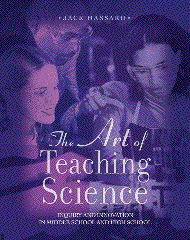Contents
Chapter 1. The
Art of Teaching Science: A Reconnaissance
Chapter 2.
Science for All
Chapter 3. The
Goals and History of Science Education
Chapter 4.
Science in the School Curriculum
Chapter 5. How
Students Learn Science
Chapter 6.
Models of Science Teaching
Chapter 7.
Designing Science Units and Courses of Study
Chapter 8.
Assessing Active Science Learning
Chapter 9.
Strategies Fostering Thinking in the Science Classroom
Chapter 10.
Facilitating Learning in the Science Classroom
Chapter 11.
Science, Technology, and Society in the Science Classroom
Chapter 12. The
Internet: Moving Toward Web-Based Learning Environments
In 2002, Karita dos Santos, the education editor for Oxford University Press encouraged me to submit a manuscript for a new book, which would be based on Minds on Science. Here was my opportunity revise completely Minds on Science. The new book, The Art of Teaching Science: Inquiry and Innovation for Middle School and High School was published by Oxford in 2005 under the editorial leadership of Maura Roessner. The book was designed as a handbook/textbook that attempted to integrate practical teaching strategies with social constructivist-based theories of learning. I drew upon my experiences in with the Global Thinking project to emphasize a humanistic science and STS approach, as well as how the Internet could be used to enhance learning. The years of seminar work, and the co-development to teacher education seminar handbooks full of practical teaching strategies was incorporated into the Art of Teaching Science. Furthermore, my close collaboration over the years with practicing science teachers led me to expand the sections on Science Teachers Talk so that in this version of the book, I included interviews with graduate of the TEEMS program, and some of their mentors.[i]
The Art of Teaching Science was characterized by the following features:
* Organizes each chapter into two sections: one that focuses on content and theme and one called the Science Teaching Gazette, a newspaper-like feature containing a variety of strategies for extending chapter concepts outside the classroom
* Opens each chapter with case studies to highlight real-world scenarios and applications of teaching theory
* Contains 42 Inquiry Activities (see the links to four examples) that provide opportunities to explore the dimensions of science teaching and increase professional expertise
* Includes Think Pieces and Problems and Extensions throughout the text to aid students in forming, developing, and sharing their ideas
* Offers chapter sections called Science Teachers Talk, written by educators from around the world to provide different points of view and encourage creative approaches to pedagogical issues
The Art of Teaching Science was reviewed by Charles Hutchison, and published in the Eurasia Journal of Mathematics, Science and Technology Education.[i] Prior to writing the final version of the book, the proposal was carefully reviewed by Elaine J. Anderson of Shippensburg University, Lynn A. Bryan of Purdue University, and Michael Dias, Kennesaw State University.

